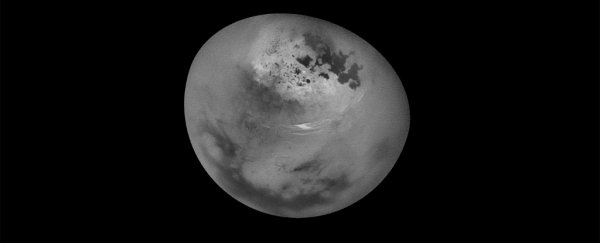Researchers working with NASA's Cassini spacecraft have witnessed clouds of methane travelling across the northern region of Titan - Saturn's largest moon - on October 29-30, which they've turned into an incredible time-lapse video.
Not only does the video provide us with a unique glimpse of the potentially habitable Titan, it provides a way for scientists to differentiate the noise - or interference - that shows up on images of the moon by mistake, from what's actually hovering above the surface.
"Time-lapse movies like this allow scientists to observe the dynamics of clouds as they develop, move over the surface and fade," the Cassini team explains.
"A time-lapse movie can also help to distinguish between noise in images (for example from cosmic rays hitting the detector) and faint clouds or fog."
Using these videos, the team hopes to build a better understanding of the moon's climate - a task that researchers have been working on since Cassini was launched in 1997, and arrived at Saturn back in 2004.
In the video below, you can see white clouds of methane form and move across the moon's surface at 7 to 10 metres per second (14 to 22 mph) before they dissipate, and fade out of existence. They look a lot like the clouds we see here on Earth.
"There are also some small clouds over the region of small lakes farther north, which fade over the course of the movie," said the team. "This small grouping of clouds is moving at a speed of about 0.7 to 1.4 miles per hour (1 to 2 metres per second)."
While the video itself is only 59 seconds long, it's actually the culmination of 11 hours of filming, with each frame taken 20 minutes apart. The team's footage loops six times during the short video, which just goes to show how hard it is to take images of a distant world.
So far, this new video is the best observation of the cloud coverage that researchers have yet obtained, providing crucial data in the pursuit of Titan's climate secrets.
In fact, the observation is already hinting at gaps in our understanding of the moon, because the researchers had predicted a larger amount of cloud cover during the early summer period in the north, but the new footage shows this isn't the case.
Having a full climate model for the moon is important, because researchers think Titan could potentially be home to alien microorganisms that thrive in methane-based atmospheres.
In fact, Titan is such a promising place for potential alien life, NASA plans on sending an autonomous submarine there to explore these rivers and seas in 2038.
For now, Cassini will continue to monitor the moon's seasons throughout 2017. By that point, Cassini will have lasted about nine years longer than originally planned, and the team says they will destroy the craft in September by flying it into Saturn.
This isn't the only time Cassini has been in the headlines lately. Earlier this year, an international team of researchers managed to use data collected by the craft to conclude that Titan is actually covered in deep canyons filled with liquid hydrocarbons, though how these canyons formed is still a mystery.
Hopefully, as Cassini nears the end of its mission, we will unwrap the secrets of Titan's climate, creating a more completed picture of one of the most talked about moons in our Solar System.
